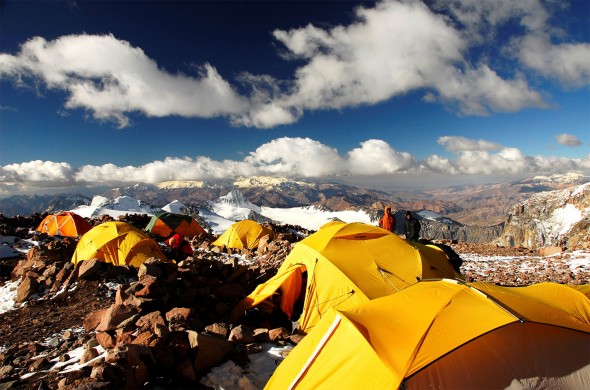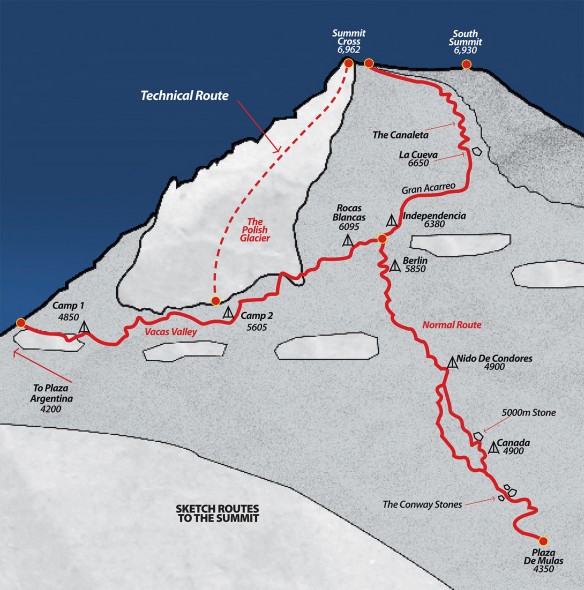Jim Ryan outlines the main trekking routes on Aconcagua
 As with any mountain, there are numerous routes up Aconcagua. The majority are categorised as extremely difficult, but there are two routes that require minimal technical expertise (i.e. they can be trekked) – the Normal Route and the Vacas Valley.
As with any mountain, there are numerous routes up Aconcagua. The majority are categorised as extremely difficult, but there are two routes that require minimal technical expertise (i.e. they can be trekked) – the Normal Route and the Vacas Valley.
The Normal Route is shorter by at least two days than the Vacas Valley (also called the Polish Glacier Route) – it’s easier and doesn’t involve wading through rivers! The Vacas Valley route, on the other hand, is quieter and less bleak. From the main road to base camp (Plaza de Mulas) on the Normal Route it’s 36 kilometres while it’s 47 kilometres to base camp (Plaza Argentina) on the Vacas Valley route. So, it is one short day’s walk, then one very long day to Plaza de Mulas, compared to three moderate days to Plaza Argentina. The distance from the base camp to the summit is a little longer and tougher on the Vacas Valley route, but eventually both routes meet before tackling the toughest part of the climb – the Canaleta. If you’re very lucky and there’s frozen snow on the Canaleta you should be able to get up it in an hour and a half, but if it’s not frozen you can expect it to take you several hours.
There is a third trekking route known as the Guanaco Route. It continues up the Vacas Valley to ascend the mountain from the north east. The area is a protected wildlife sanctuary, however, and the route has never been opened by the park authorities. Apart from the attraction of there being less people, this route would not really have any advantage over the other two – and it’s longer to base camp plus there’s an extra river to cross.
After arriving at the base camps, most expeditions take a week to 10 days to get to the summit, shuffling up and down between the upper three camps. From top camp, summit day is a climb of over 1,100m, so you need to be prepared for a long slog.
Need to know
When to go: The climbing season on Aconcagua starts in mid-November and ends in mid-March. Eighty per cent of trekkers go in December and January.
How to get there: To reach Aconcagua you can fly to either Buenos Aires or Santiago de Chile and get an internal flight or bus to Mendoza. The nearest village is Puente del Inca. Another stop-off point is the ski resort of Los Penitentes.
Permits: You need a permit to climb the mountain. Costing around £350, the permit covers your consultation with the base camp doctor and a helicopter evacuation if you fall ill.
Guides: Although you can climb the mountain independently if you wish, most climbers sign up with an operator. Head to the Mendoza Government website (www.aconcagua.mendoza.gov.ar) for a list of the licensed operators and guides.
Acclimatisation: Three quarters of climbers fail to reach the summit often due to high-altitude sickness. Take acclimatisation seriously and make use of medical tents at base camp.
Specialist operators: Jagged Globe, Mountain Trip, World Expeditions
Essential reading: Aconcagua and the Southern Andes, by Jim Ryan (Cicerone)


